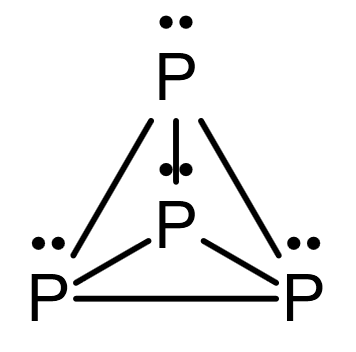
Nitrogen exists as a diatomic molecule and phosphorus as \[{P_4}\]. Why?
Answer
221.1k+ views
Hint: Due to repulsion between the bound atoms, the smaller atoms can make numerous bonds, whereas the large molecule cannot. Applying this concept on the given questions helps in reaching the answer.
Complete Step by Step Solution:
Both nitrogen and phosphorus belong to the same family of elements. As a result, their valence shell electrical configurations are identical. They have a lot of chemical features in common because of their electrical arrangement. There are some distinctions between nitrogen and phosphorus, such as size, effective nuclear charge, and so on.
The size of the metal grows as we travel down in the group. The size grows as a group electron is added to the next principal quantum number, increasing the distance between the outermost shell electrons and the nucleus. As a result, the effective nuclear charge falls, and the size grows.
As a result, phosphorus is more abundant than nitrogen. The effective nuclear charge of nitrogen is higher than that of phosphorus.
Because of its tiny size and high effective nuclear charge, nitrogen can establish as many bonds as it wishes to complete its octet with another nitrogen atom. The nitrogen atom has five valence electrons; thus, it needs three more to complete its octant and create a triple bond with another nitrogen atom.
The high effective nuclear charge aids in the binding of a large number of electrons in a tiny space between the two nitrogen atoms. Because of its small size, another nitrogen atom can get close enough to stabilize the diatomic nitrogen molecule, allowing it to live as a diatomic molecule.
Because of its huge size and ineffective nuclear charge, phosphorus is unable to create as many bonds as it would want to complete its octant with another phosphorus atom. When phosphorus forms a triple bond with another phosphorus atom, the repulsion between the two phosphorus atoms becomes so strong that the diatomic phosphorus molecule becomes unstable. As a result, it exists as \[{P_4}\] to complete its octet and reduce repulsion.
The structure of nitrogen is as follows:

Image: Structure of Nitrogen
The structure of \[{P_4}\] is as follows:

Image: structure of \[{P_4}\]
Note: The stability of a single bond is lower than that of a triple bond. As a result, the triple-bonded nitrogen atoms are closer together than the four single-bonded phosphorus atoms. The advantage of being in the \[{P_4}\] state is that the phosphorus octet is completed. Single bond atoms remain as far apart as feasible to reduce repulsion.
Complete Step by Step Solution:
Both nitrogen and phosphorus belong to the same family of elements. As a result, their valence shell electrical configurations are identical. They have a lot of chemical features in common because of their electrical arrangement. There are some distinctions between nitrogen and phosphorus, such as size, effective nuclear charge, and so on.
The size of the metal grows as we travel down in the group. The size grows as a group electron is added to the next principal quantum number, increasing the distance between the outermost shell electrons and the nucleus. As a result, the effective nuclear charge falls, and the size grows.
As a result, phosphorus is more abundant than nitrogen. The effective nuclear charge of nitrogen is higher than that of phosphorus.
Because of its tiny size and high effective nuclear charge, nitrogen can establish as many bonds as it wishes to complete its octet with another nitrogen atom. The nitrogen atom has five valence electrons; thus, it needs three more to complete its octant and create a triple bond with another nitrogen atom.
The high effective nuclear charge aids in the binding of a large number of electrons in a tiny space between the two nitrogen atoms. Because of its small size, another nitrogen atom can get close enough to stabilize the diatomic nitrogen molecule, allowing it to live as a diatomic molecule.
Because of its huge size and ineffective nuclear charge, phosphorus is unable to create as many bonds as it would want to complete its octant with another phosphorus atom. When phosphorus forms a triple bond with another phosphorus atom, the repulsion between the two phosphorus atoms becomes so strong that the diatomic phosphorus molecule becomes unstable. As a result, it exists as \[{P_4}\] to complete its octet and reduce repulsion.
The structure of nitrogen is as follows:

Image: Structure of Nitrogen
The structure of \[{P_4}\] is as follows:

Image: structure of \[{P_4}\]
Note: The stability of a single bond is lower than that of a triple bond. As a result, the triple-bonded nitrogen atoms are closer together than the four single-bonded phosphorus atoms. The advantage of being in the \[{P_4}\] state is that the phosphorus octet is completed. Single bond atoms remain as far apart as feasible to reduce repulsion.
Recently Updated Pages
The hybridization and shape of NH2 ion are a sp2 and class 11 chemistry JEE_Main

What is the pH of 001 M solution of HCl a 1 b 10 c class 11 chemistry JEE_Main

Aromatization of nhexane gives A Benzene B Toluene class 11 chemistry JEE_Main

Show how you will synthesise i 1Phenylethanol from class 11 chemistry JEE_Main

The enolic form of acetone contains a 10sigma bonds class 11 chemistry JEE_Main

Which of the following Compounds does not exhibit tautomerism class 11 chemistry JEE_Main

Trending doubts
Understanding Atomic Structure for Beginners

Understanding Entropy Changes in Different Processes

Common Ion Effect: Concept, Applications, and Problem-Solving

What Are Elastic Collisions in One Dimension?

Free Radical Substitution and Its Stepwise Mechanism

Understanding Geostationary and Geosynchronous Satellites

Other Pages
JEE Advanced 2026 Revision Notes for Practical Organic Chemistry

NCERT Solutions For Class 11 Chemistry Chapter 7 Equilibrium in Hindi - 2025-26

Understanding Centrifugal Force in Physics

JEE Main Marking Scheme 2026- Paper-Wise Marks Distribution and Negative Marking Details

Devuthani Ekadashi 2025: Correct Date, Shubh Muhurat, Parana Time & Puja Vidhi

Difference Between Exothermic and Endothermic Reactions: Key Differences, Examples & Diagrams




